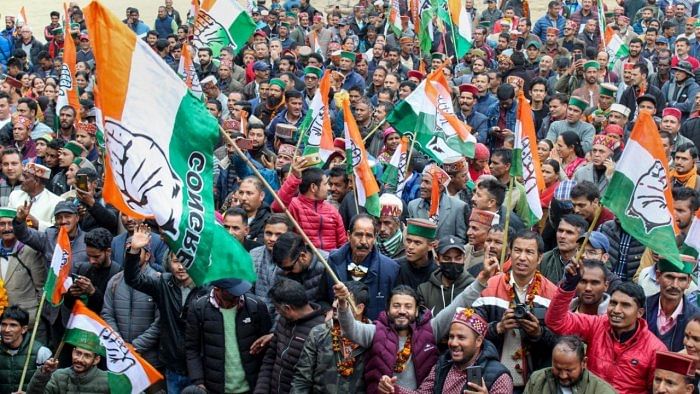
Congress has found itself on the edge of a collapse in Gujarat mainly after failing to hold on to non-BJP voters though consolation in this round of Assembly elections came in for the party in Himachal Pradesh where it unseated the BJP – a victory in a state after losing 18 Assembly elections since 2018.
Adding one more state to its kitty is something to cheer for the Congress in the “days of doom”, as party leaders read it as putting brakes on the “Congress-mukt Bharat” (Congress-free India) juggernaut of the BJP and its supreme leader Narendra Modi but reversing of growth trajectory in Gujarat has taken the sheen out of Himachal victory.
Also Read: Gujarat results prove lack of Congress relevance in leading any national front: Trinamool
Election after election, the Congress has been improving its position in Gujarat since 1990 –.from 33 seats and 30.74 per cent votes in 1990 to 77 seats and 41.44 per cent votes in 2017. A lacklustre campaign and directionless leadership by Congress amid AAP’s high decibel presence left Congress with just 17 seats and a little over 27 per cent votes.
Congress president Mallikarjun Kharge “humbly accepted” the mandate and diagnosed where the party failed, “We will strengthen the organisation afresh, this is our promise.”
Though it has lost all Lok Sabha contests in 2014 and 2019 with Gujarat voters preferring the BJP with Modi at the helm, Congress has always been reckoned as a major player in state politics. Assembly elections.
Also Read: How the BJP campaigned in Gujarat elections
It enjoyed close to 40 per cent votes since 2002 but this time an invisible party on the ground meant that several non-BJP voters shifted to AAP, which gathered nearly 13 per cent votes. The scale of the party’s defeat in Gujarat is one that will hurt the Congress, as it once again seeks to reinforce Congress’ inability to electorally counter the BJP and lead the Opposition.
AAP eating into Congress votes signals that the anti-BJP voters are looking at options other than Congress despite knowing well the BJP could return to power. The results also showed the famed KHAM (Khastriya, Harijan, Adivasi and Muslim), conceptualised by Madhavsinh Solanki that led to Congress’ record victory in 1985, formula lies in shambles.
As its star leader Rahul kept himself busy with Bharat Jodo Yatra and when he reluctantly came for a day, he appeared aloof, Congress claimed it was doing door-to-door campaigning but the voters were not impressed.
However, Congress General Secretary (Communications) Jairam Ramesh differs. He agrees the Gujarat result was “disappointing” but argues that his party was pitted against “a three party alliance of BJP, AAP and AIMIM, a campaign of provocative polarisation and machinery of state and Centre”. He tweeted that vote share gives them “hope and confidence for rebuilding and revival. We are the only alternative in Gujarat.”
In Himachal, the stage was set for the Congress aided by anti-incumbency against the BJP but there were jitters as its campaign was not perceived as effective. Despite repeated requests from state leaders, Rahul did not campaign in Himachal while his sister and General Secretary Priyanka Vadra showed up for a handful of road shows and rallies.
They had the right campaign themes to highlight and cash in on – from return to Old Pension Scheme, promise of jobs, fight against the ‘Agniveer’ scheme in a state which sends a substantial number of youth to the military and the anger among the apple growers.
Though the campaign was lacklustre in Himachal, voters chose issues that concern their lives over the charm and charisma of Modi, indicating that a vigorous and planned campaign based on specific issues could work against the BJP. Also to be seen is that Congress was a divided house and there was no Virbhadra Singh-like towering figure to steer the party.
